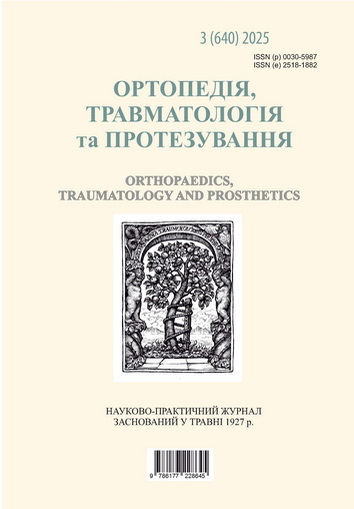BIOMECHANICAL ANALYSIS OF SHORT-SEGMENT PEDICLE SCREW FIXATION FOR AO TYPE A FRACTURES AT THE THORACOLUMBAR JUNCTION UNDER EXTENSION LOADING
DOI:
https://doi.org/10.15674/0030-59872025326-36Keywords:
Burst fracture, thoracolumbar junction, short-segment transpedicular fixation, intermediate screws, extension loading, finite element method, spinal biomechanicsAbstract
Thoracolumbar junction fractures account for up to 60 % of all spinal injuries, with more than 20 % classified as burst fractures. These injuries are characterized by instability and an increased risk of kyphotic deformity. Short-segment transpedicular fixation, which has been gradually gaining favor as the treatment of choice for burst fractures in this region, undoubtedly reduces invasiveness but can lead to fixation failure if there is no intermediate support in the body of the injured vertebra. Objective. To evaluate the stress-strain state of the thoracolumbar spine with a burst fracture at ThXII under extension loading, considering screw length and the presence of intermediate fixation. Methods. A finite element model of the spine (ThIX–LV) with a burst fracture at ThXII was developed. Four variants of shortsegment transpedicular fixation were analyzed: short or long (bicortical) screws, with or without additional screws in ThXII. A 350 N load was applied to ThIX, and stresses were determined at control points using the von Mises criterion. Results. The highest stresses in the connecting rods were observed with long screws without intermediate fixation (337.2 MPa). Introducing intermediate screws decreased the stress in ThXII from 16.2 to 9.8 MPa. Short screws with ThXII fixation distributed loads more effectively, reducing peak stresses. Long screws led to overload at the entry points (up to 12.8 MPa in LI), while their maximum stress reached 95.1 MPa. Conclusions. Intermediate fixation of the injured vertebra reduces stress in both bone structures and the implant, thereby decreasing the risk of correction loss. The most favorable configuration is a combination of short screws with intermediate fixation. Long screws are advisable in cases of osteoporosis, although they increase local stresses — a factor that must be taken into consideration during surgical planning.
Downloads
How to Cite
Issue
Section
License
Copyright (c) 2025 Oleksii Nekhlopochyn, Vadim Verbov, Ievgen Cheshuk, Mykhailo Karpinsky, Olexander Yaresko

This work is licensed under a Creative Commons Attribution 4.0 International License.
The authors retain the right of authorship of their manuscript and pass the journal the right of the first publication of this article, which automatically become available from the date of publication under the terms of Creative Commons Attribution License, which allows others to freely distribute the published manuscript with mandatory linking to authors of the original research and the first publication of this one in this journal.
Authors have the right to enter into a separate supplemental agreement on the additional non-exclusive distribution of manuscript in the form in which it was published by the journal (i.e. to put work in electronic storage of an institution or publish as a part of the book) while maintaining the reference to the first publication of the manuscript in this journal.
The editorial policy of the journal allows authors and encourages manuscript accommodation online (i.e. in storage of an institution or on the personal websites) as before submission of the manuscript to the editorial office, and during its editorial processing because it contributes to productive scientific discussion and positively affects the efficiency and dynamics of the published manuscript citation (see The Effect of Open Access).














